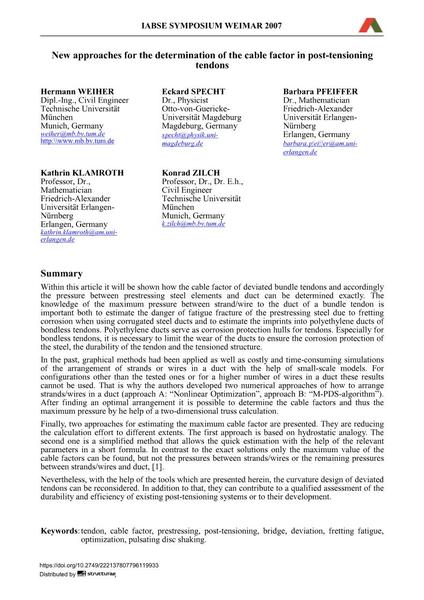New approaches for the determination of the cable factor in post-tensioning tendons

|
|
|||||||||||
Bibliografische Angaben
| Autor(en): |
Hermann Weiher
E. Specht B. Pfeiffer K. Klamroth Konrad Zilch |
||||
|---|---|---|---|---|---|
| Medium: | Tagungsbeitrag | ||||
| Sprache(n): | Englisch | ||||
| Tagung: | IABSE Symposium: Improving Infrastructure Worldwide, Weimar, Germany, 19-21 September 2007 | ||||
| Veröffentlicht in: | IABSE Symposium Weimar 2007 | ||||
|
|||||
| Seite(n): | 126-127 | ||||
| Anzahl der Seiten (im PDF): | 9 | ||||
| Jahr: | 2007 | ||||
| DOI: | 10.2749/222137807796119933 | ||||
| Abstrakt: |
Within this article it will be shown how the cable factor of deviated bundle tendons and accordingly the pressure between prestressing steel elements and duct can be determined exactly. The knowledge of the maximum pressure between strand/wire to the duct of a bundle tendon is important both to estimate the danger of fatigue fracture of the prestressing steel due to fretting corrosion when using corrugated steel ducts and to estimate the imprints into polyethylene ducts of bondless tendons. Polyethylene ducts serve as corrosion protection hulls for tendons. Especially for bondless tendons, it is necessary to limit the wear of the ducts to ensure the corrosion protection of the steel, the durability of the tendon and the tensioned structure. In the past, graphical methods had been applied as well as costly and time-consuming simulations of the arrangement of strands or wires in a duct with the help of small-scale models. For configurations other than the tested ones or for a higher number of wires in a duct these results cannot be used. That is why the authors developed two numerical approaches of how to arrange strands/wires in a duct (approach A: “Nonlinear Optimization”, approach B: “M-PDS-algorithm”). After finding an optimal arrangement it is possible to determine the cable factors and thus the maximum pressure by he help of a two-dimensional truss calculation. Finally, two approaches for estimating the maximum cable factor are presented. They are reducing the calculation effort to different extents. The first approach is based on hydrostatic analogy. The second one is a simplified method that allows the quick estimation with the help of the relevant parameters in a short formula. In contrast to the exact solutions only the maximum value of the cable factors can be found, but not the pressures between strands/wires or the remaining pressures between strands/wires and duct, [1]. Nevertheless, with the help of the tools which are presented herein, the curvature design of deviated tendons can be reconsidered. In addition to that, they can contribute to a qualified assessment of the durability and efficiency of existing post-tensioning systems or to their development. |
||||
| Stichwörter: |
Brücke Spannglied Vorspannung
|
||||
